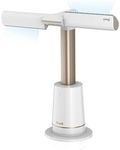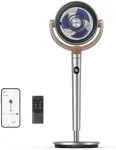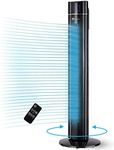Buying Guide for the Best Tower Fans
When choosing a tower fan, it's important to consider your specific needs and the environment in which you'll be using the fan. Tower fans are designed to provide efficient airflow in a compact, vertical design, making them ideal for small spaces or areas where you want to save floor space. They are generally quieter than traditional fans and can offer a range of features that enhance comfort and convenience. To find the best tower fan for you, consider factors such as room size, noise level, and additional features like remote control or air purification.Airflow CapacityAirflow capacity refers to the amount of air a fan can move, usually measured in cubic feet per minute (CFM). This spec is crucial because it determines how effectively the fan can cool a room. Higher CFM means more air movement, which is ideal for larger spaces or hotter environments. For small rooms or personal use, a lower CFM might be sufficient. Consider your room size and how much cooling you need when choosing the airflow capacity.
Noise LevelNoise level is measured in decibels (dB) and indicates how loud the fan will be when operating. This is important if you plan to use the fan in a bedroom or office where quiet is essential. Fans with lower dB ratings are quieter, making them suitable for nighttime use or quiet environments. If noise is not a concern, you might opt for a fan with higher airflow capacity, which can be louder.
OscillationOscillation refers to the fan's ability to rotate side to side, distributing air more evenly throughout a room. This feature is important for ensuring that air circulates effectively, especially in larger spaces. Fans with wider oscillation angles can cover more area, making them ideal for living rooms or open-plan spaces. If you need focused airflow, a fan with limited or no oscillation might be preferable.
Speed SettingsSpeed settings allow you to adjust the fan's airflow intensity. This is important for customizing comfort based on your preferences and the room's temperature. Fans typically offer multiple speed settings, ranging from low to high. More settings provide greater flexibility, allowing you to choose a gentle breeze or a powerful airflow. Consider how much control you want over the fan's performance when selecting speed settings.
Remote ControlA remote control feature allows you to operate the fan from a distance, adding convenience, especially if the fan is placed in a hard-to-reach area. This is particularly useful for adjusting settings without having to get up, making it ideal for use in bedrooms or living rooms. If ease of use is a priority, look for fans that include a remote control.
Timer FunctionThe timer function lets you set the fan to turn off after a certain period, which can be useful for energy saving and ensuring comfort while sleeping. This feature is important if you want the fan to operate for a specific duration without manual intervention. Consider how often you'll use the fan and whether a timer would be beneficial for your routine.
Air PurificationSome tower fans come with air purification features, such as HEPA filters, which can help remove dust, pollen, and other allergens from the air. This is important for improving air quality, especially if you have allergies or live in a polluted area. If air quality is a concern, look for fans with built-in purification systems to enhance your environment.















